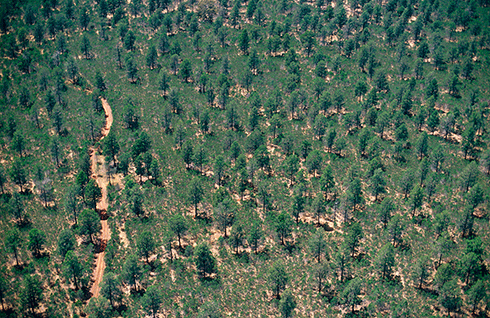
|
Published: 23 April 2014
Plants can play a role in avoiding dangerous global warming: Climate Institute
Technologies that remove heat-trapping carbon pollution from the atmosphere are now central to a lower risk strategy to avoid highly dangerous climate change, according to a new study released by The Climate Institute last week, following the release of the IPCC’s third Fifth Assessment report.
‘Physics tells us that if we are to avoid very dangerous global warming of 2°C or more above pre-industrial levels, Australia and other countries need not only zero carbon technologies like solar and wind but also to go further, and employ carbon removal technologies,’ says John Connor, CEO of The Climate Institute.
The report, Moving Below Zero: Understanding Bio-energy with Carbon Capture & Storage includes a world-first study examining the role of carbon removal technologies in national climate policy scenarios.
Carried out by economics firm Jacobs SKM, the modelling finds that bio-energy with carbon capture and storage (CCS), or bio-CCS using food wastes, sustainable forest biomass, or crop residues, has the potential to contribute significantly to climate change efforts in Australia.
‘We examined a range of carbon removal options including afforestation, bio-char and bio-CCS,’ explains Connor.
‘Bio-CCS is potentially the most climate-safe technology, as it involves removing carbon from the air and storing in the earth over geological timescales.
‘Globally it could remove a substantial amount of carbon pollution from the air – up to 10 billion tonnes of pollution per year in 2050, according to the International Energy Agency.’
Using Australia as a case study, Jacobs SKM economic modelling concluded that:
-
Bio-CCS could play a significant role in Australia, with a capacity to remove and displace up to 65 million tonnes of CO2 equivalent (MtCO2-e) annually by 2050. That is around 1.5 times current emissions from all cars in Australia.
-
Early and strong action on climate is needed, with renewables and other low-carbon technologies being critical from today. For example, energy efficiency and other renewable energy sources like wind and solar are required to reduce electricity emissions by 50 per cent, from around 200 Mt CO2-e today to 100 Mt CO2-e in 2030 across all scenarios.
-
Without bio-CCS and other carbon removal technologies, Australia and other nations will face difficult trade-offs: accept more dangerous levels of climate change, pay more for emission reductions, and/or purchase more and more emission reductions from other countries. The report finds that failure to adopt carbon removal technologies could increase climate action costs by up to AU$60 billion to 2050.
‘Carbon removal technologies are hugely important but they have to be employed correctly. If bio-energy is not sourced from sustainable sources and consider energy used at all stages of the process, it can lead to other social and environmental impacts and undermine the viability of, and public confidence in, the technology,’ adds Connor.
‘With carbon dioxide levels now 40 per cent above pre-industrial levels, it is critical that we begin the conversation now about how to sustainably integrate carbon removal technologies into national climate policies with long term decarbonisation signals and deployment incentives.
The report builds on a previous Climate Institute publication, Below Zero, which explores the need for ‘below-zero’ emissions and examined some carbon-removal technologies including:
-
Afforestation and wood storage: Forests absorb carbon and deforestation is a leading cause of rising emissions. Estimates for emission removal from afforestation and wood stage vary greatly, from 1.3 to 14 billion tonnes of CO2 removed per year in 2030. This includes not just harvesting sustainably and planting new trees.
-
Bio-char: This charcoal-like material is created by heating biomass in a low-oxygen environment. It results in fixing the carbon into the bio-char, preventing it from decomposing or returning to the air. Bio-char can be mixed into farmlands to improve the soil condition, enhancing water retention and improving soil quality. This in turn improves plant growth; taking in more CO2. Estimates of global carbon removal potential are around 0.15 GtCO2-e per year, rising to 3.7 GtCO2-e by 2030.
-
Bio-CCS: As plants grow, they harness energy from the sun and CO2 from the air. Certain plants can be harvested, transported and processed to form a fuel which can be combusted or fermented to produce bioenergy (heat, power or transport). This process releases the CO2 which can be captured, compressed and transported to a location for geological storage. This means the CO2 absorbed from the air during plant growth could be removed from the natural carbon cycle. This process is known as bio-CCS.
-
Other emerging technologies: New technologies, such as artificial trees and direct air capture, are being developed by some to mimic natural carbon removal processes.
Source: Climate Institute




